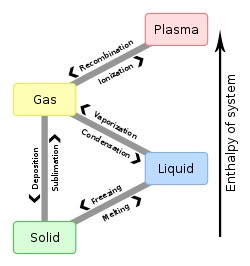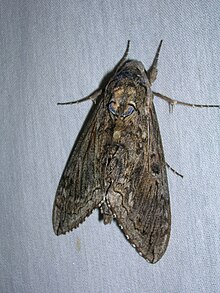람다점
Lambda point람다 지점은 정상 유체 헬륨(헬륨 I)이 초유체 헬륨 II(1기압에서 약 2.17K)로 이행하는 온도입니다.He-I와 He-II가 공존할 수 있는 최저 압력은 2.1768K(-270.9732°C) 및 5.048kPa(0.04982 atm)에서 증기-He-I-I-II 삼중점이며, 이 온도에서 "포화증기 압력"(0.04982 atm)이다.He-I와 He-II가 공존할 수 있는 가장 높은 압력은 1.762K(-271.388°C), 29.725atm(3011.9kPa)[2]에서 헬륨 고체로 이루어진 BCC-He-I-He-II 트리플포인트이다.
점의 이름은 그리스 문자 람다{\(\와 유사한 온도 함수로서 비열 용량을 표시한 그래프(그림)에서 유래했습니다. 비열 용량은 온도만큼 날카로운 피크를 가집니다.람다 포인트에 접근합니다.피크의 끝은 매우 날카로우므로 열 용량의 분산을 특징짓는 임계 지수는 무중력 상태에서만 정확하게 측정하여 상당한 양의 유체에서 균일한 밀도를 제공할 수 있습니다.따라서 [3]열 용량은 1992년 우주왕복선 페이로드에 포함된 실험에서 전이 아래의 2nK 내에서 측정되었다.
열 용량은 피크를 가지지만 무한대로 향하지는 않지만(그래프가 시사하는 것과 반대로), [3]위와 아래에서 천이에 접근할 때 유한한 제한값을 갖는다.피크 부근의 열용량 거동은 A ± - +± {\ Ct^{-\alpha{\pm}} (서 t 1 - t= 1 - T/ } ± , ± {\},{\pm [3][5]는 상수(전이 온도 이상과 가 다름)이며, 는 임계 지수:- 입니다. 이 지수는 초유체 [6]전이가 음수이므로 유한 전이가 유지됩니다.
인용된 실험값 α는 고온 팽창 기법, 몬테 카를로 방법 및 등각 부트스트랩에서 도출된 가장 정확한 이론적 결정과[8][9][10] 상당한 차이가[7][4] 있다.
「 」를 참조해 주세요.
레퍼런스
- ^ Donnelly, Russell J.; Barenghi, Carlo F. (1998). "The Observed Properties of Liquid Helium at the Saturated Vapor Pressure". Journal of Physical and Chemical Reference Data. 27 (6): 1217–1274. Bibcode:1998JPCRD..27.1217D. doi:10.1063/1.556028.
- ^ Hoffer, J. K.; Gardner, W. R.; Waterfield, C. G.; Phillips, N. E. (April 1976). "Thermodynamic properties of 4He. II. The bcc phase and the P-T and VT phase diagrams below 2 K". Journal of Low Temperature Physics. 23 (1): 63–102. Bibcode:1976JLTP...23...63H. doi:10.1007/BF00117245. S2CID 120473493.
- ^ a b c Lipa, J.A.; Swanson, D. R.; Nissen, J. A.; Chui, T. C. P.; Israelsson, U. E. (1996). "Heat Capacity and Thermal Relaxation of Bulk Helium very near the Lambda Point". Physical Review Letters. 76 (6): 944–7. Bibcode:1996PhRvL..76..944L. doi:10.1103/PhysRevLett.76.944. hdl:2060/19950007794. PMID 10061591.
- ^ a b Rychkov, Slava (2020-01-31). "Conformal bootstrap and the λ-point specific heat experimental anomaly". Journal Club for Condensed Matter Physics. doi:10.36471/JCCM_January_2020_02.
- ^ Lipa, J. A.; Nissen, J. A.; Stricker, D. A.; Swanson, D. R.; Chui, T. C. P. (2003-11-14). "Specific heat of liquid helium in zero gravity very near the lambda point". Physical Review B. 68 (17): 174518. arXiv:cond-mat/0310163. Bibcode:2003PhRvB..68q4518L. doi:10.1103/PhysRevB.68.174518. S2CID 55646571.
- ^ 다른 위상 의 경우 α: Ising 임계 지수를 갖는 액체-증기 임계 지점의 경우 αδ +.1\ +1)가 음수일 수 있습니다.이러한 상전이의 경우 특정 열은 무한대에 도달하는 경향이 있습니다.
- ^ Vicari, Ettore (2008-03-21). "Critical phenomena and renormalization-group flow of multi-parameter Phi4 theories". Proceedings of the XXV International Symposium on Lattice Field Theory — PoS(LATTICE 2007). Regensburg, Germany: Sissa Medialab. 42: 023. doi:10.22323/1.042.0023.
- ^ Campostrini, Massimo; Hasenbusch, Martin; Pelissetto, Andrea; Vicari, Ettore (2006-10-06). "Theoretical estimates of the critical exponents of the superfluid transition in $^{4}\mathrm{He}$ by lattice methods". Physical Review B. 74 (14): 144506. arXiv:cond-mat/0605083. doi:10.1103/PhysRevB.74.144506. S2CID 118924734.
- ^ Hasenbusch, Martin (2019-12-26). "Monte Carlo study of an improved clock model in three dimensions". Physical Review B. 100 (22): 224517. arXiv:1910.05916. Bibcode:2019PhRvB.100v4517H. doi:10.1103/PhysRevB.100.224517. ISSN 2469-9950. S2CID 204509042.
- ^ Chester, Shai M.; Landry, Walter; Liu, Junyu; Poland, David; Simmons-Duffin, David; Su, Ning; Vichi, Alessandro (2020). "Carving out OPE space and precise O(2) model critical exponents". Journal of High Energy Physics. 2020 (6): 142. arXiv:1912.03324. Bibcode:2020JHEP...06..142C. doi:10.1007/JHEP06(2020)142. S2CID 208910721.





 상수(전이 온도 이상과
상수(전이 온도 이상과 




